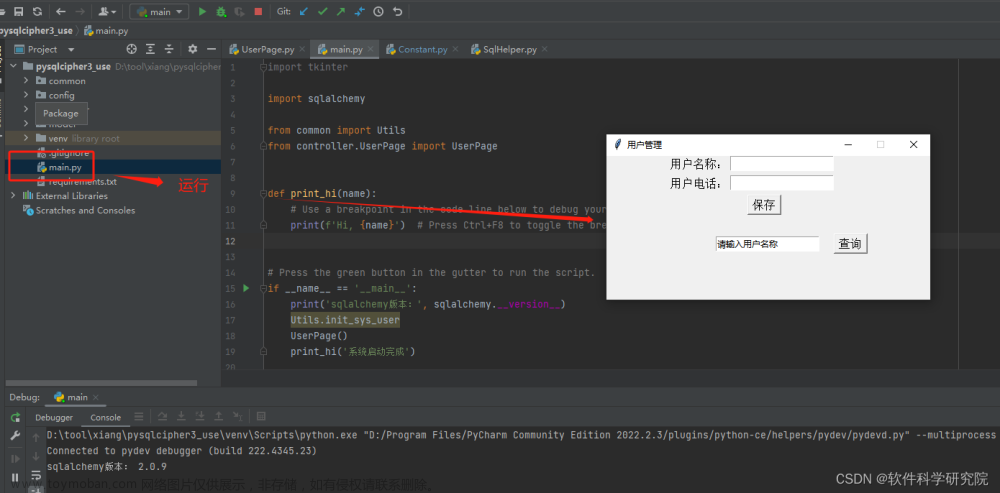创建一个新的子应用 opt
python manage.py startapp opt
注册子应用
INSTALLED_APPS = [
'django.contrib.admin',
'django.contrib.auth',
'django.contrib.contenttypes',
'django.contrib.sessions',
'django.contrib.messages',
'django.contrib.staticfiles',
'rest_framework',
'students',
'sers', # 序列化器
"school", # 序列化器嵌套
'req', # 请求与响应
'demo', # 视图
'opt', # drf提供的组件使用
]
总路由,代码:
from django.contrib import admin
from django.urls import path, include
urlpatterns = [
path('admin/', admin.site.urls),
path('students/', include("students.urls")),
path('sers/', include("sers.urls")),
path('school/', include("school.urls")),
path("req/", include("req.urls")),
path("demo/", include("demo.urls")),
path("opt/", include("opt.urls")),
]
子路由,代码:
from django.urls import path
from . import views
urlpatterns = [
]
因为接下来的认证组件中需要使用到登陆功能,所以我们使用django内置admin站点并创建一个管理员.
admin运营站点的访问地址:http://127.0.0.1:8000/admin
python manage.py createsuperuser
# 如果之前有账号,但是忘了,可以通过终端下的命令修改指定用户的密码,这里的密码必须8位长度以上的
python manage.py changepassword 用户名
创建管理员以后,访问admin站点,先修改站点的语言配置
settings.py
LANGUAGE_CODE = 'zh-hans'
TIME_ZONE = 'Asia/Shanghai'
1. 认证Authentication
可以在配置文件中配置全局默认的认证方案
常见的认证方式:cookie、session、token
/home/moluo/.virtualenvs/drfdemo/lib/python3.6/site-packages/rest_framework/settings.py 默认配置文件
REST_FRAMEWORK = {
# 配置认证方式的选项
'DEFAULT_AUTHENTICATION_CLASSES': (
'rest_framework.authentication.SessionAuthentication', # session认证
'rest_framework.authentication.BasicAuthentication', # 基本认证
)
}
也可以在具体的视图类中通过设置authentication_classess类属性来设置单独的不同的认证方式
from rest_framework.authentication import SessionAuthentication, BasicAuthentication
from rest_framework.views import APIView
class ExampleView(APIView):
# 类属性
authentication_classes = [SessionAuthentication, BasicAuthentication]
def get(self,request):
pass
认证失败会有两种可能的返回值,这个需要我们配合权限组件来使用:
- 401 Unauthorized 未认证
- 403 Permission Denied 权限被禁止
自定义认证,drfdemo.authentication代码:
from rest_framework.authentication import BaseAuthentication
from django.contrib.auth import get_user_model
class CustomAuthentication(BaseAuthentication):
"""
自定义认证方式
"""
def authenticate(self, request):
"""
认证方法
request: 本次客户端发送过来的http请求对象
"""
user = request.query_params.get("user")
pwd = request.query_params.get("pwd")
if user != "root" or pwd != "houmen":
return None
# get_user_model获取当前系统中用户表对应的用户模型类
user = get_user_model().objects.first()
return (user, None) # 按照固定的返回格式填写 (用户模型对象, None)
视图调用自定义认证,视图代码:
from django.contrib.auth.models import AnonymousUser
from django.shortcuts import render
from rest_framework.views import APIView
from rest_framework.response import Response
from rest_framework.authentication import SessionAuthentication
from drfdemo.authentication import CustomAuthentication
# Create your views here.
class HomeAPIView(APIView):
# authentication_classes = [CustomAuthentication, ]
def get(self,request):
"""单独设置认证方式"""
print(request.user) # 在中间件AuthenticationMiddleware中完成用户身份识别的,如果没有登录request.user值为AnonymousUser
if request.user.id is None:
return Response("未登录用户:游客")
else:
return Response(f"已登录用户:{
request.user}")
当然,也可以注释掉上面视图中的配置,改成全局配置。settings.py,代码:
"""drf配置信息必须全部写在REST_FRAMEWORK配置项中"""
REST_FRAMEWORK = {
# 配置认证方式的选项【drf的认证是内部循环遍历每一个注册的认证类,一旦认证通过识别到用户身份,则不会继续循环】
'DEFAULT_AUTHENTICATION_CLASSES': (
'drfdemo.authentication.CustomAuthentication', # 自定义认证
'rest_framework.authentication.SessionAuthentication', # session认证
'rest_framework.authentication.BasicAuthentication', # 基本认证
)
}
2. 权限Permissions
权限控制可以限制用户对于视图的访问和对于具有模型对象的访问。
- 在执行视图的as_view()方法的dispatch()方法前,会先进行视图访问权限的判断
- 在通过get_object()获取具体模型对象时,会进行模型对象访问权限的判断
使用
可以在配置文件中全局设置默认的权限管理类,如
REST_FRAMEWORK = {
....
'DEFAULT_PERMISSION_CLASSES': (
'rest_framework.permissions.IsAuthenticated',
)
}
如果未指明,则采用如下默认配置文章来源:https://www.toymoban.com/news/detail-706595.html
'DEFAULT_PERMISSION_CLASSES': (
'rest_framework.permissions.AllowAny',
)
也可以在具体的视图中通过permission_classes属性来进行局部设置,如文章来源地址https://www.toymoban.com/news/detail-706595.html
from django.contrib.auth.</到了这里,关于DRF03-权限与分页的文章就介绍完了。如果您还想了解更多内容,请在右上角搜索TOY模板网以前的文章或继续浏览下面的相关文章,希望大家以后多多支持TOY模板网!










